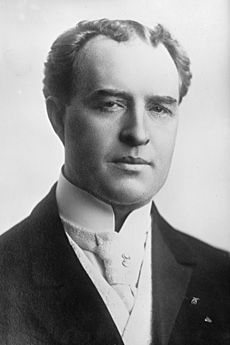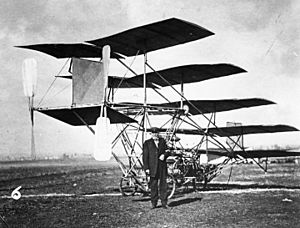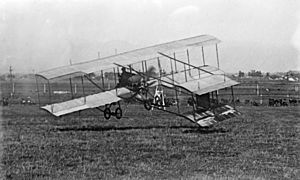1910 Los Angeles International Air Meet at Dominguez Field facts for kids
The Los Angeles International Air Meet was a very early airshow, held from January 10 to January 20, 1910. It was the first big airshow in the United States. This exciting event took place in Los Angeles County, California, at a place called Dominguez Field. This field was near the Dominguez Rancho Adobe in what is now Rancho Dominguez, California. About 254,000 people came to watch the show over 11 days. The Los Angeles Times newspaper even called it "one of the greatest public events in the history of the West."
Contents
The Start of Airshows and Planning for Los Angeles
Early Airshows Around the World
The famous Wright brothers, Wilbur and Orville Wright, made their first flight on December 17, 1903. In the early 1900s, many people were trying to build the first successful airplane. The Wrights worked hard to improve their aircraft design.
In 1908, the Wright brothers finally showed their amazing flying skills to the public. On August 8, 1908, in France, Wilbur Wright amazed everyone. He flew his plane with easy turns and circles. People like Louis Blériot, another aviation pioneer, were stunned.
In 1909, several airshows took place. These shows featured competitions, aircraft makers, and pilots. There was a big show in Frankfurt, Germany, and another in Reims, France. The Frankfurt show, which started in July 1909, claims to be the world's first multi-participant airshow. The Reims airshow in August 1909 attracted more than half a million people! Soon after, Charles Willard and A. Roy Knabenshue decided to create the first big airshow in the United States. They planned it for the winter of 1909-1910.
Getting Ready for the Los Angeles Air Meet
Knabenshue and Willard chose the Los Angeles, California area because of its good winter weather. Glenn Curtiss, a famous pilot, promised to join. So, Knabenshue contacted Dick Ferris, a local promoter. Ferris then got local businesses involved and formed a committee to organize the event.
They first thought about a field near Santa Anita Park. But there were too many tall trees there. So, the aviators looked for another spot. By December 1909, they picked Dominguez Field. This field was on a small hill that was once part of a large Spanish land grant called Rancho San Pedro.
Once the location was set, they started promoting the air meet. They built large grandstands that could hold 50,000 to 60,000 people. A camp for the aviators was also built nearby. The local Pacific Electric Railway station even expanded its platform. This was to help all the visitors traveling from downtown Los Angeles.
Organizers invited pilots flying different types of aircraft. These included monoplanes, biplanes, balloons, and dirigibles. To make the event truly "international," they invited French aviator Louis Paulhan. Paulhan was a star from the 1909 Reims meet. He was guaranteed some money to encourage him to attend. Cash prizes were also offered for competitions in altitude (how high), speed, and endurance (how long a flight lasted).
The Big Event: What Happened
Who Participated?

The 1910 Air Meet attracted many famous aviators, mostly from America. Glenn Curtiss, an American aviation pioneer, was the most well-known. Other pilots included Roy Knabenshue, Charles Willard, Lincoln Beachey, Charles K. Hamilton, Howard Warfield Gill, and Clifford B. Harmon. Many of these pilots are known as "Early Birds of Aviation." French aviators like Louis Paulhan and Didier Masson also attended.
The Wright brothers did not fly in the event. However, they were there with their lawyers. They tried to stop Paulhan and Curtiss from flying. The Wrights claimed that the ailerons (parts of the wing that help steer) on their aircraft used their patented ideas. But despite these claims, Paulhan and Curtiss still flew their planes.
Paulhan even gave newspaper publisher William Randolph Hearst his first airplane ride! However, William Boeing, who later founded his own aircraft company, could not get a ride. He was very excited about airplanes. He asked almost every pilot for a ride, but only Louis Paulhan said yes. Boeing waited for three days, but Paulhan left the meet before giving him a ride. This was a big missed chance for Paulhan!
Local Creations and Inventors
Besides the famous aviators, many hobbyists and inventors came to the meet. They hoped to become famous in the new aviation world. A $1500 prize was offered for a plane designed and built by a local person that could fly five miles or more. This encouraged many inventors from California to show up. Some of their planes were copies or changes of successful designs, like the Bleriot monoplane. But some were truly new and original ideas.
One very unusual plane was the "Multi-plane" by James Slough Zerbe from Los Angeles. It had five separate sets of wings attached to a complex frame. Sadly for Zerbe, his creation hit a hole in the field during takeoff. It broke several wings and could not fly.
Zerbe also built a "double biplane" for W.J. Davis. This machine had "four decks of equal size," two in front and two in back, and two propellers.
A.E. Mueller, another Los Angeles resident, built a huge aircraft. The LA Times newspaper called it "Mueller’s Monster." They said it was "by far the largest aeroplane in existence." The plane was 75 feet long and 50 feet wide. It had a 600 lb (272 kg), 50 hp engine and weighed about a ton. Mueller thought that making such a heavy machine would help it stay stable in light winds.
J.H. Klassen, also from Los Angeles, built a gyroplane for the contest. He also entered a monoplane. His gyroplane design was "quite novel," according to the LA Times. It had "two 12-foot circular planes in the front, and two 8-foot planes in the rear." Klassen hoped the "gyroscopic motion of the revolving planes" would make the craft very stable in the air.
List of Participants
Here is a list of some of the participants and their aircraft:
| Participant | From | Aircraft |
|---|---|---|
| Glenn Curtiss | Hammondsport, New York | Curtiss Biplane |
| Louis Paulhan | Paris, France | Farman Biplane & Bleriot Monoplane |
| Didier Masson | Paris, France | Bleriot Monoplane |
| Charles E. Miscarol | Paris, France | Bleriot Monoplane |
| Baroness de la Roche | Paris, France | Bleriot Monoplane |
| Clifford B. Harmon | New York City, New York | Curtiss Biplane |
| Charles Keeney Hamilton | Hammondsport, New York | Curtiss Biplane |
| H. P. Warner | Beloit, Wisconsin | Curtiss Biplane |
| Grant Fowler (aviator) | Tucson, Arizona | Triplane |
| Charles Borok | New York | Monoplane |
| Louis Bergdoll | Philadelphia, Pennsylvania | Bleriot Monoplane |
| Ralph Saunier | New York | Monoplane |
| Donald H. Gordon | Bostonia, California | Aeroplane |
| J. W. Curzon | Cincinnati, Ohio | Farman Biplane |
| Dana P. Goodwin | San Francisco, California | Monoplane |
| W. M. Williams | Douglas, Arizona | Monoplane |
| A. Roy Knabenshue | Toledo, Ohio | Aeroplane |
| Harry La Verne Twining | Los Angeles, California | Ornithopter |
| J. C. Klassen | Los Angeles, California | Gyroplane & Monoplane |
| William Stephens (aviator) | Los Angeles, California | Monoplane |
| A. L. Smith (aviator) | Los Angeles, California | Biplane |
| A.J. Gonzales | Los Angeles, California | Bowplane |
| James Slough Zerbe | Los Angeles, California | Multiplane |
| H.L. Reimer | Los Angeles, California | Ornithopter |
| E.S. Smith | Tropico, California | Monoplane |
| La Platt Brothers | Yuma, Arizona | Ornithopter |
| James A. Liston | San Diego, California | Biplane |
| S. Y. Beach | New York | Monoplane |
| H.W. Gale | New York | Aeroplane |
| B.F. Roerig | San Diego, California | Biplane |
| G.H. Loose | San Francisco, California | Monoplane |
| Waldo Dean Waterman | San Diego, California | Biplane |
| E.J. Campbell | Los Angeles, California | Biplane |
| W.J. Davis | Los Angeles, California | Double Biplane |
| D.J. Johnson | Los Angeles, California | Aeroplane |
| Richard Griffith Vere Mytton | Los Angeles, California | Biplane |
| Charles Skogland | Los Angeles, California | Monoplane |
| Charles F. Willard | New York | Curtiss Biplane |
| Howard Gill | Baltimore, Maryland | Gill-dosh Biplane |
How Many People Attended?
About 254,000 tickets were sold for the air meet. The ticket sales brought in around $137,500. During the event, streetcars ran to Dominguez Fields every 2 minutes from the Pacific Electric station in Los Angeles. The huge crowds, with over 20,000 people each day, made the event very profitable.
A 9-year-old girl named Florence Leontine Lowe, who later became famous as "Pancho" Barnes, was brought to the show by her grandfather. She was so inspired that she later became a pilot herself! By the end of the event, the organizers announced a profit of $60,000 after giving out prize money.
Competitive Flying Events
Aviators competed for $75,000 in prizes. To compete, pilots would tell the judges which prize they were trying for. Then, they would fly around the 1.61 km (1 mile) course. They always flew in an anti-clockwise direction. Pilots were told not to fly over the grandstands or crowds without permission. If they did, they would be penalized.
All flights between 2 p.m. and sunset counted for scoring. Pilots were encouraged to fly as many times as possible each day. They also tried to set as many records as they could. If a pilot did not complete at least one full circuit of the course between 2 p.m. and 5 p.m. each day, they were penalized. Only the best time was counted for judging at the end of the meet.
Balloon competitions were also held in Huntington Park during the week. These events included attempts to set new altitude records and passenger flights.
Prizes Offered
Here are some of the prizes offered at the air meet (in 1910 US dollars):
- $10,000.00 for the plane that carried two or more people and broke all world records for how long it flew, how high it flew, how far it flew, and how fast it flew.
- $7,500.00 for the plane with the best overall performance in all events.
- $5,000.00 for setting a new height record.
- $5,000.00 for setting a new endurance record (longest flight time).
- $500.00 for the smallest circle flown.
- $500.00 for the shortest take-off time.
- $500.00 for the shortest take-off distance.
- $500.00 for the "greatest ability during flight" (overall flying skill).
- $500.00 for the longest glide with the engine turned off.
- $500.00 for the best landing at a specific spot.
- $1,500.00 for any aircraft designed and built by a resident of California, Arizona, or Nevada that could fly 5 miles (8 km) or more.
- $500.00 for any aircraft designed and built by a resident of California, Arizona, or Nevada that could fly 2 miles (3.2 km) or more.
- $2,500 for a plane that could "soar" (stay in the air without power, not just glide) using only the pilot's power.
- $10,000.00 for a dirigible flight from Los Angeles to San Francisco.
- $5,000.00 for a non-stop dirigible flight with more than two passengers from Los Angeles to San Diego and back.
- $10,000.00 for a balloon flight to the Atlantic Coast without landing.
- $5,000.00 for the first balloon flight to the east of the Mississippi River without landing.
- $2,500.00 for breaking Count de la Vaux's long-distance balloon record of 1193 miles (1920 km).
- $2,500.00 for the first balloon to land within 5 miles (8 km) of San Francisco.
Who Won the Prizes?
Louis Paulhan was the big winner at the Dominguez meet. He won $19,000 in prize money! His achievements included:
- Setting a new flight endurance record: He flew with a passenger for almost 177 kilometers (110 miles) in his Farman III biplane in 1 hour and 49 minutes.
- Setting a new altitude record: He reached about 1,269 meters (4,164 feet) high.
Paulhan also performed many amazing aerial stunts during the week. On January 19, he even took U.S. Army 1st Lieutenant Paul W. Beck up for one of the first tests of dropping bombs from a plane.
Glenn Curtiss set a new air speed record of about 89 kilometers per hour (55 miles per hour). He also won the prize for the best quick start. In total, he won about $6,500.
A Historical Landmark
The location of Dominguez Field is now a California Historical Landmark (No. 718). It was given this honor on December 2, 1959. A plaque near the site reminds everyone of this important event. It says:
About one half mile southeast of this spot, on Dominguez Hill in historic Rancho San Pedro, the first air meet in the United States was held during January 10–20, 1910. Subsequently, this area has evolved into one of the world's leading aviation-industrial centers.





